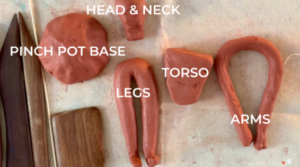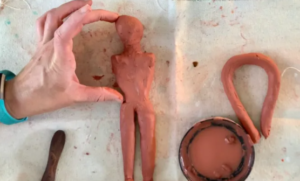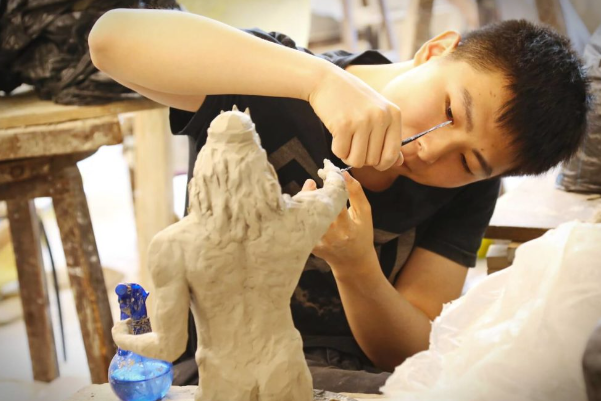Table Of Contents
- 1 Session 1: Unveiling the Potential of Clay Sculpting in Art Education
- 2 Session 3: Building a Sculpted Learning Experience
- 3 Session 4: Sculpting a Legacy: Conclusions and FAQs
- 3.1 The Enduring Impact of Clay Sculpting in Art Education:
- 3.2 Key Takeaways:
- 3.3 Frequently Asked Questions:
- 3.4 1. What are the age-appropriate clay sculpting techniques for young children?
- 3.5 2. How can I assess student progress in clay sculpting?
- 3.6 3. What resources are available for integrating clay sculpting into my curriculum?
- 3.7 4. How can I encourage parental involvement in my clay sculpting program?
- 3.8 5. How can I ensure the sustainability of a clay sculpting program?
Session 1: Unveiling the Potential of Clay Sculpting in Art Education
Introduction:
Art education plays a vital role in fostering creativity, self-expression, and critical thinking in young minds. While traditional art forms offer valuable tools for learning and exploration, incorporating clay sculpting into the curriculum adds a unique and transformative dimension.
Clay sculpting, with its tactile nature and limitless creative possibilities, provides an engaging and accessible platform for students of all ages and backgrounds to explore their artistic potential. This hands-on learning experience goes beyond the confines of paper and canvas, nurturing a deeper understanding of art and its connection to the world around us.
Exploring the Advantages:
Incorporating clay sculpting into art education offers a multitude of benefits, including:
Enhancing Fine Motor Skills: The act of manipulating and shaping clay strengthens the small muscles in hands and fingers, promoting fine motor development essential for writing, drawing, and other daily activities.
Unleashing Creativity and Imagination: Clay sculpting offers a boundless creative playground where students can freely explore their imaginations, transforming ideas into tangible forms. This process fosters problem-solving skills and encourages students to think outside the box.
Promoting Sensory Exploration: The diverse textures and malleability of clay engage the senses, allowing students to explore the world through touch and develop a deeper sensory awareness.
Building Confidence and Self-Esteem: Successfully creating a sculpture with their own hands provides a sense of accomplishment and boosts students’ confidence and self-esteem. This feeling of empowerment encourages them to persevere in the face of challenges and embrace new artistic endeavors.
Fostering Collaboration and Teamwork: Collaborative clay sculpting projects teach valuable social skills like teamwork, communication, and compromise. Students learn to share ideas, work together towards a common goal, and appreciate the diverse perspectives of their peers.
Developing 3D Spatial Skills: Manipulating clay in three dimensions refines students’ spatial reasoning and visualization skills, which are crucial for success in various fields like engineering, architecture, and design.
Providing a Stress Relief Outlet: The rhythmic and tactile nature of clay sculpting can serve as a calming and therapeutic activity, helping students manage stress and anxiety. This mindful practice promotes emotional well-being and enhances overall focus and concentration.
Adapting to Different Learning Styles: Clay sculpting caters to various learning styles, offering kinesthetic learners a hands-on approach, visual learners a chance to create tangible forms, and auditory learners opportunities to discuss and share ideas. This inclusivity ensures all students have the opportunity to thrive in the art classroom.
Connecting to Other Subjects: Clay sculpting can be used as a springboard for exploring other subjects like history, science, and literature. This interdisciplinary approach helps students make connections between different areas of knowledge and gain a holistic understanding of the world.
Cultivating a Lifelong Love of Art: Positive experiences with clay sculpting at a young age can ignite a lifelong passion for art and creativity. This appreciation for the arts enriches students’ lives and encourages them to continue exploring and expressing themselves through various artistic mediums.
Conclusion:
Integrating clay sculpting into art education unlocks a world of possibilities for students, nurturing creativity, self-expression, and essential life skills. This engaging and transformative learning experience empowers young minds to explore their artistic potential and discover the joy of creation.

Session 2: Delving Deeper into the Meaning of “Incorporating Clay Sculpting into Art Education”
Breaking Down the Key Concepts:
In the previous session, we explored the overarching theme of incorporating clay sculpting into art education. Now, let’s delve deeper into the individual components of this concept:
- Clay Sculpting: A hands-on art form involving manipulating malleable clay to create three-dimensional sculptures. This process engages various skills, including hand-eye coordination, fine motor control, and spatial reasoning.
- Art Education: The process of teaching and learning about visual arts, encompassing various mediums and techniques. Art education aims to cultivate artistic skills, critical thinking, self-expression, and appreciation for different art forms.
- Incorporation: The act of integrating clay sculpting into the existing art curriculum, ensuring its seamless and effective application within the learning environment.
Understanding the Synergy:
Combining these elements creates a synergistic relationship where clay sculpting becomes a powerful tool for enhancing art education. This fusion:
- Expands the artistic repertoire: Clay offers a unique and tactile medium unlike traditional drawing and painting, enriching the learning experience and engaging students with diverse interests.
- Enhances learning outcomes: Clay sculpting fosters various skills beyond pure artistic expression, including problem-solving, collaboration, and critical thinking, contributing to holistic development.
- Promotes accessibility: The tactile nature of clay makes it an accessible medium for students of all abilities, including those with learning differences or physical limitations.
- Deepens engagement: Clay sculpting provides a hands-on and engaging learning experience that motivates students, increases their interest in art, and promotes active participation.
- Connects to real-world applications: Clay sculpting allows students to explore real-world concepts like 3D design, architecture, and engineering, fostering a deeper connection between art and science.
Moving Beyond the Traditional:
Incorporating clay sculpting into art education is not simply about adding another task to the curriculum. It involves a shift in mindset, embracing a more holistic approach that recognizes the unique value and benefits this medium offers. This requires:
- Adapting teaching methods: Educators need to develop engaging lesson plans and activities that leverage the unique properties of clay and cater to diverse learning styles.
- Creating a supportive environment: Providing adequate resources, including tools, materials, and dedicated workspace, is crucial for fostering a creative and conducive learning environment.
- Promoting collaboration and sharing: Encouraging students to work together on clay projects and share their creations fosters a sense of community and encourages peer learning.
- Connecting with the arts community: Engaging with professional artists, visiting exhibitions, and exploring diverse art forms can enrich the learning experience and inspire students.
- Embracing lifelong learning: Educators themselves should be open to continuous learning and exploration, updating their knowledge and skills in clay sculpting techniques and pedagogical approaches.
By embracing these principles, educators can harness the transformative power of clay sculpting and create a vibrant and engaging art education environment that fosters creativity, self-expression, and a lifelong love of art in all students.

Session 3: Building a Sculpted Learning Experience
Bringing Clay Sculpting to Life in the Classroom:
In our previous sessions, we explored the numerous benefits and key concepts involved in incorporating clay sculpting into art education. Now, let’s move from theory to practice and delve into the practical aspects of implementing this transformative approach.
1. Designing Engaging Activities and Lesson Plans:
- Start with the basics: Introduce students to the properties of clay, basic shaping techniques, and safe handling practices.
- Cater to different learning styles: Offer a variety of projects that appeal to visual, kinesthetic, and auditory learners.
- Integrate across disciplines: Link clay projects to history, science, literature, or other subjects for a more holistic learning experience.
- Embrace open-ended exploration: Encourage students to explore their own creative ideas and experiment with different techniques.
- Incorporate collaborative projects: Team-based clay sculptures foster teamwork, communication, and problem-solving skills.
2. Cultivating a Supportive Learning Environment:
- Provide adequate resources: Ensure access to high-quality clay, various tools, appropriate workspace, and storage for unfinished projects.
- Create a dedicated space: Designate an area specifically for clay sculpting activities with proper ventilation, lighting, and cleaning facilities.
- Set clear expectations: Establish guidelines for behavior, safety, and project completion to ensure a positive and productive learning environment.
- Promote self-expression and creativity: Encourage students to express their individuality and experiment with different styles and themes in their sculptures.
- Offer constructive feedback: Provide helpful feedback that focuses on improvement and encourages students to reach their full potential.
3. Fostering Collaboration and Sharing:
- Organize group projects: Assign collaborative clay projects that require students to work together towards a common goal.
- Create a gallery space: Showcase finished clay sculptures in a designated area to celebrate student achievements and foster peer appreciation.
- Host guest artists: Invite professional clay sculptors to share their expertise and inspire students through demonstrations and workshops.
- Organize field trips: Visit museums, exhibitions, or artist studios to expose students to diverse art forms and broaden their artistic horizons.
- Promote peer learning: Encourage students to share their knowledge and skills with each other, fostering a supportive and collaborative learning community.
4. Embracing Continuous Learning:
- Stay updated on best practices: Attend workshops, conferences, or online courses to learn new clay sculpting techniques and pedagogical approaches.
- Seek feedback from colleagues and mentors: Share your experiences and challenges with other educators to gain valuable insights and improve your teaching methods.
- Reflect on your practice: Regularly evaluate the effectiveness of your clay sculpting lessons and make adjustments based on student feedback and your own observations.
- Experiment and explore new possibilities: Encourage innovation and be open to trying new techniques and incorporating emerging technologies into your lessons.
- Maintain a passion for art: Keep your own creative spirit alive by engaging in personal art projects and exploring different artistic mediums.
By embracing these practical strategies and fostering a supportive learning environment, educators can unlock the full potential of clay sculpting in art education. This transformative approach will empower students to develop essential life skills, nurture their creativity, and discover a lifelong love of art.
Session 4: Sculpting a Legacy: Conclusions and FAQs
The Enduring Impact of Clay Sculpting in Art Education:
As we conclude our exploration of incorporating clay sculpting into art education, it’s clear that this approach offers a unique and transformative learning experience for students of all ages and backgrounds. By engaging students in hands-on creation and fostering a supportive environment, we cultivate essential skills like creativity, critical thinking, communication, and collaboration.
Key Takeaways:
- Clay sculpting provides a tactile and engaging medium that complements traditional art forms and expands the artistic repertoire.
- The benefits extend beyond artistic expression, fostering fine motor skills, problem-solving, and a sense of accomplishment.
- Clay sculpting is accessible to students of all abilities and learning styles, promoting inclusivity and engagement.
- This hands-on learning experience can be integrated with other subjects, enriching the understanding of diverse disciplines.
- Clay sculpting can spark a lifelong passion for art and inspire students to continue exploring their creative potential.
Frequently Asked Questions:
1. What are the age-appropriate clay sculpting techniques for young children?
- Pinch pot technique
- Coil construction
- Slab building
- Stamping and texturing
- Simple sculpting with tools
2. How can I assess student progress in clay sculpting?
- Observe their engagement and participation in activities.
- Evaluate their understanding of basic techniques and concepts.
- Assess their creativity and effort showcased in their sculptures.
- Provide constructive feedback and encourage self-reflection.
3. What resources are available for integrating clay sculpting into my curriculum?
- Online lesson plans and tutorials
- Books and articles on clay sculpting techniques
- Professional development workshops and conferences
- Collaborative networks and online communities of art educators
4. How can I encourage parental involvement in my clay sculpting program?
- Offer workshops and information sessions for parents.
- Organize family clay sculpting events and exhibitions.
- Share student work and progress through online platforms.
- Encourage parents to support their child’s creative exploration at home.
5. How can I ensure the sustainability of a clay sculpting program?
- Secure funding for clay materials and equipment.
- Partner with local businesses or community organizations for support.
- Organize fundraising events to generate additional resources.
- Apply for grants and awards for arts education programs.
By incorporating clay sculpting into art education, we provide students with a unique and valuable tool for self-discovery, skill development, and artistic expression. This transformative approach has the potential to shape young minds and leave a lasting legacy of creativity and appreciation for the arts.

1 thought on “Incorporating Clay Sculpting Into Art Education”